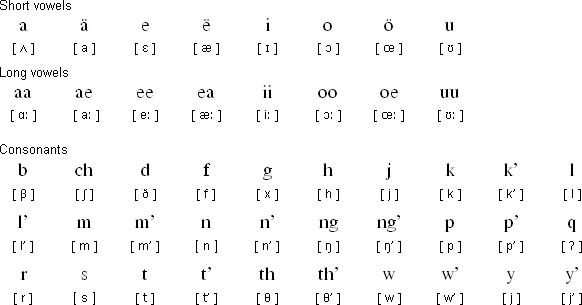Yapese is a member of the Oceanic branch of the Malayo-Polynesian language family. It is spoken by about 5,000 people in the island of Yap, part of the Federated States of Micronesia, an archipelago of islands in the Pacific Ocean to the northeast of Papua New Guinea.
In Yapese, the island of Yap is known as Waqa(a)b or Waab, and the language is known as Thin nu Waqab or Thin nu Wa’ab. It has official status in Yap, along with Ulithian, Woleaian Satawalese and English. There are words borrowed from Spanish, German, Japanese and English in Yapese, largely as a result of colonial occupation, and Japanese is spoken by some older Yapese people.
Yapese first appeared in writing in a work on Yapese grammar, Primer Ensayo de Gramatica de la lengua de Yap, by Fr. Ambrosio de Valencina, a Spanish missionary, which was published in Manila in 1888. The Spanish-based spelling system for Yapese used by Fr. de Valencina remained in use until 1972, when the Yapese Orthography Committee came up with a new spelling system. Not all the changes, such as the use of the letter q for glottal stops, have been universally accepted.

Download an alphabet chart for Yapese (Excel)
Gubine gidii mani gargeleg nga faileng nibapuf matt'awen nge rogon. Bay laniyan nipii e nam, ere ngauda ted matt'aawen e chaa niba chugur ngoded nimod walag dad.
All human beings are born free and equal in dignity and rights. They are endowed with reason and conscience and should act towards one another in a spirit of brotherhood.
(Article 1 of the Universal Declaration of Human Rights)
Information about Yapese | Phrases | Numbers | Tower of Babel
Information about Yapese language
http://en.wikipedia.org/wiki/Yapese_language
http://faroutliers.blogspot.com/2004/08/yapese-spelling-reform-that-damn-q.html
http://olac.ldc.upenn.edu/language/yap
Phrases in Yapese
https://quizlet.com/181561397/yapese-phrases-flash-cards/
Adzera, Ahamb, Äiwoo, Aneityum, Apma, Araki, Are, ’Auhelawa, Avava, Babatana, Bariai, Bola, Big Numbas, Buhutu, Bwaidoka, Caac, Cheke Holo, Dorig, Hiri Motu, Hiw, Hoava, Kakabai, Kaninuwa, Kokota, Kove, Kurti, Lakon, Lehali, Lenakel, Lewo, Lote, Lo-Toga, Löyöp, Manam, Marovo, Maskelynes, Mato, Mavea, Mono-Alu, Motu, Mussau-Emira, Mwotlap, Nafsan, Nahavaq, Namakura, Nanggu, Nduke, Neve‘ei, Neverver, Ninde, North Efate, Nume, Paamese, Papapana, Raga, Rotuman, Roviana, Sa, Sakao, Saliba, Siar, Sio, Ske, Sobei, Sursurunga, Tamambo, Tami, Teanu, Tigak, Tirax, Tolai, Touo, Ubir, Ughele, Uneapa, Vatlongos, Vitu, Vurës, Western Fijian, Yabem, Yapese
Languages written with the Latin alphabet
Page last modified: 05.10.24
[top]
You can support this site by Buying Me A Coffee, and if you like what you see on this page, you can use the buttons below to share it with people you know.

If you like this site and find it useful, you can support it by making a donation via PayPal or Patreon, or by contributing in other ways. Omniglot is how I make my living.
Note: all links on this site to Amazon.com, Amazon.co.uk
and Amazon.fr
are affiliate links. This means I earn a commission if you click on any of them and buy something. So by clicking on these links you can help to support this site.
[top]